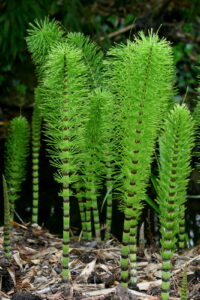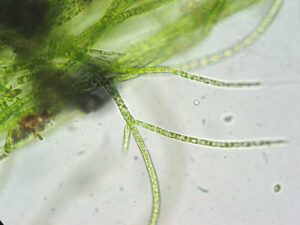A magnificent diversity of plants that reproduce without seeds automatically creates the planet’s surface.
Plants that reproduce without seeds constitute only a small part of the plants in our terrestrial landscape. Around three hundred million years ago, seedless plants took control of the landscape and started growing in a vast area of swampy forests in the Carboniferous period.
The dead bodies of these plants form a large blanket of coal that we mine in present days. We will discuss a few seedless plant examples here. Modern-day seedless vascular plants may include the following:
- Bryophytes
- Liverworts
- Hornworts
- Tracheophytes
- Club mosses
- Horsetails
- Ferns
- Whisk ferns
- Algae
- Mushroom
According to existing evolutionary theory, all plants, including green algae and land plants (land dwellers), are monophyletic, meaning they are all the descendants of a single ancestor.
The plants had to struggle enough to go through the transition of water plants to land plants. They had to develop their characteristics of avoiding drying out without water, had to scatter reproductive cells in air, had to develop strength and support for different structure and also had to be different than water plants for sunlight to be captured and filtered.
Another difference between seed and seedless plants is that seed plants evolved modifications that permitted them to thrive in even the driest environments on the planet, but many seedless plants nevertheless need to be kept wet. Not all plants have achieved complete water independence.
Some seedless plant examples:
Bryophytes
The nonvascular plants known as bryophytes are the closest living relatives of ancient terrestrial plants. The oldest bryophytes made their appearance some 490 million years ago, during the Ordovician epoch.
As they are nonvascular plants, they lack lignin like vascular plants. Lignin is a strong polymer found in the cell walls that are present on the stems of vascular plants.
Due to these parts and further resistant structures, the possibility of bryophytes forming their fossils is greatly reduced. Although some spores comprised of sporopollenin have been identified, they have been linked to ancient bryophytes.
There are about 18,000 species of bryophytes, which thrive mostly in damp habitats, although some grow in deserts. In a bryophyte, all the conspicuous vegetative organs belong to the haploid organism, or gametophyte. The diploid sporophyte is barely noticeable.
Bryophytes consist of about 18,000 species of its own species that are mainly found in the swampy areas, though some bryophytes can also grow in the desert habitats.
In a bryophyte, all the responsible vegetative organs belong to the organism that is haploid in nature, or gametophyte. But the sporophyte which is rarely noticeable is diploid in nature.
The bryophytes form gametes that can swim with the help of flagella. Bryophytes contain sporangium, a multicellular structure that helps in reproduction. The embryo present remains connected with the parent plant, so that it can help in the nourishment of the embryo. The land plants comprise this characteristic feature.
Liverworts
Liverworts that belong to the phylum Marchantiophyta may be considered as plants that belong to a close relation to the ancestor plants that shifted to the terrestrial. Liverworts have populated many domains in the environment and more than 6,000 existing species have been added to the mix.
Lobate are the green structures that are formed by some gametophytes. The shape of the lobes is comparable to that of the liver, which is where the common name comes from for this division.
The cycle of the reproduction system begins when there is a release of haploid spores from the sporangium that has developed on the sporophyte. These spores are then dispersed by water or wind so that they can germinate into a flattened structure called a thalli, which is joined to the substrate by means of filaments that are thin and single celled.
Male and female gametangia develop on separate, individual plants. When a spore is released, the male gametes swim towards the female gametangium or the archegonium with the help of their flagella, and thus fertilization takes place.

The zygote begins to develop into a small sporophyte which still remains connected to the parent gametophyte. During the process of meiosis, it gives rise to the spore of the next generation.
Liverwort plants can also reproduce without parents being interacted with each other. This process is done by the branches that are broken or by scattering of the fragments of the leaves known as gemmae.
The gemmae are the small, whole, complete bits of plant generated that are found on the surface of the thallus in the form of a cup. Their process of reproduction is something different. While there is rain, raindrops splatter these out of the cup-like structure. Thus the gemmae get somewhere nearby and further develop into gametophytes.
Hornworts
The hornworts that belong to the phylum Anthocerotophyta have a populated diversity of domains on land, despite the fact that they are rarely far from a supply of water. Hornworts have almost 100 species of their own varieties. The short, blue-green gametophyte is the most common period in the life of hornworts.
The sporophyte is the group’s defining trait. It’s a long, narrow pipe-like structure that sprouts from the parent gametophyte and continues to grow throughout the plant’s life.

Stomata are present in the hornworts and the sporophyte has a lot of them. Photosynthetic cells that are present in the thallus comprises of a single chloroplast.
Meristem cells that are found at the bottom of the plant continue to divide and add to the height of the plant. Several hornworts develop symbiotic relationships with cyanobacteria that help in the fixation of nitrogen from the environment.
Tracheophytes
Tracheophytes are the vascular plants that form the controlling and most noticeable part of terrestrial group of plants. Earth’s 90 percent of the total vegetation consist of the tracheophytes that represent more than 260,000 of its species. Their success and capacity to spread to all habitats is due to a number of evolutionary advances.
In the vascular plants that are seedless, the sporophyte which is diploid in nature is the dominant phase of the lifecycle. The gametophyte has evolved into a quiet, self-contained organism. In the dominant period of the lifecycle, there has been a clear reversal of roles throughout plant history.
The seedless vascular plants are still dependent on water during the process of fertilization so that the sperm can swim on a layer of moisture with the help of flagella towards the egg. This step in the reproductive process explains why ferns and their companions thrive in moist conditions.
Club mosses
The club mosses belong to the phylum Lycopodiophyta. On the forest floor, horsetails with their jointed stalks and wiry leaves grow on tree trunks, while mosses thrive on tree trunks.
The club mosses that belong to the phylum Lycopodiophyta are the most ancient category of vascular plants that are seedless in nature. They inhabited the Carboniferous terrain, expanding to be tall trees and establishing vast wetland forests.
The phylum Lycopodiophyta has almost 1,200 species, which includes other plants like the quillworts (Isoetales), the club mosses (Lycopodiales), and spike mosses (Selaginellales). None of these are bryophytes or true mosses. Lycophytes can be either homosporous or heterosporous.
Horsetails
Horsetails, whisk ferns and ferns all belong to the same phylum named Monilophyta. But horsetail is placed in the different category, that is, Class Equisetopsida.
The genus named Equisetum is the sole survivor of the Arthrophyta, a vast group of plants that produced gigantic trees and extensive swamp forests during the Carboniferous. The plants are frequently found in marshes and moist regions.

The leaves and branches come out in the form of coils from the joints that are equally spaced. The process of photosynthesis is mostly carried out by the green part present on the stem. The leaves are not able to take part in photosynthesis because of their needle-shape.
The stiffness of horsetail plants is due to the presence of silica that is collected in the cells of the epidermis. Rhizomes are the names of the stems that grow under the ground that anchor the plant to the ground. Nowadays, these horsetails are homosporous in nature, and they produce gametophytes that are bisexual.
Ferns
Ferns are believed to be the most modern vascular plants that are seedless and they show the features that are commonly seen in plants that consist of seeds. Ferns form large leaves and branching roots.
Ferns can be easily recognized as seedless vascular plants due to the presence of their enormous fronds. The stems of the ferns are often considered rhizomes, notwithstanding the fact that rhizomes are present only in a few species that grow underground. Ferns are terrestrial plants.
A few species of ferns can grow up to a height of 20 metres, that is, 66 feet tall, for instance, Cyathea brownii found on Norfolk Island and Cyathea medullaris present in New Zealand. New leaves usually grow into stalks by unwrapping a tight spiral known as crozier or fiddlehead. Leaves of ferns are categorized into two groups namely- sporophylls and tropophylls.
Spores are produced by sporophylls, whereas tropophylls do not produce any spores. The underground organisms present do not perform photosynthesis, and they receive their nutrients and water from the soil. They are usually fibrous in nature, and their structure is extremely similar to that of the roots present in seed plants.
Ferns are found in a wide range of habitats, from the tropics to temperate woods. Even if some species can thrive in arid conditions, most ferns prefer wet, shady areas.
Whisk ferns
Psilotum nudum, known as the whisk fern, is a plant that is similar to the ferns. Just like the other species present in the order Psilotales, it does not contain roots. The name, Psilotum nudum, suggests “bare naked” in Latin, as it is deprived or appears to lack many of the organs that are found in typical vascular plants, as an outcome of evolutionary reduction.
Whisk ferns are also known as the psilophytes as they lack both leaves and roots in them, which can be a consequence of evolutionary reduction. Photosynthesis is carried out by the green part of the stem of the whisk fern. The embryo consists of only two parts namely- distal shoot apex and proximal foot.
The shoot apex gives rise to a rhizome where the roots are absent. This is because P. nudum and its other relatives may also be considered epiphytes sometimes. Rather than roots, the rhizome will gradually generate drastically diminished leaves. Auxin concentrations have a big impact on these processes.
Sporangia are present at the top of the branch where tiny yellow knobs like structures are found. Whisk ferns are categorized beyond the true ferns. Recent studies of DNA illustrates that this group of ferns and whisk ferns both lost their roots as well as their vascular tissues during the evolutionary period.
The plant, that grows wild in the southern part of Japan, was once cultivated in a large amount in the Japanese gardens in the form of an ornamental plant.
P. nudum can be found in the tropical areas of Africa, tropical Asia, central America, the southern part of America, tropical and subtropical North America, Australia, Hawaii, the southern part of Japan, the Island of Lord Howe, New Zealand, and a few remote areas in South-West Europe.
Algae
Algae, whose singular form is alga, are the members of a category named Kingdom Protista. They are the predominantly aquatic organisms that can carry out the process of photosynthesis. The study of algae is known as phycology, and the person who studies about algae is known as a phycologist.
Their pigments that help carry out photosynthesis are very much different from those found in normal plants. So, they have cells whose traits do not match those of other plants and animals. Algae is necessary economically because it is the source of crude oil. Sometimes they are also consumed as food products. Algae has several pharmaceutical and industrial uses for humans.
Just like the plants mentioned above, algae is also deficient in true roots, leaves, and stems. They share traits that are similar to those of the avascular lower plants, such as hornworts, mosses, and liverworts.

In the beginning of the 1830s, algae were categorized into some important classes based on their color, such as green, red, and brown. These colors are basically the reflection of various pigments in the chloroplast like chlorophyll, carotenoids, and anthocyanins, as well as some water-soluble proteins such as phycobiliproteins.
The size of algae has a different range of magnitude. For example, sometimes algae may be of a single cell organism, while the largest size of algae may comprise of millions of cells. According to the morphology of their vegetative, growth, or mode, algae can be classified into numerous categories:
1. Filamentous forms that have cells where they are strung together like beads, for example in Spirogyra.
2. Parenchymatous forms, or tissue like formations, such as in Macrocystis, which is the giant kelp that can be several metres in length.
3. Algae that are coenocytic, like the green seaweed named Codium, can grow to quite enormous sizes without developing discrete cells. Coenocytic algae are generally multinucleated in nature, unicellular algae with no cell walls that divide the protoplasm (cytoplasmic and nuclear components of a cell).
Few algae comprises of flagella so that they can swim through the water.
Mushroom
A mushroom, often known as a toadstool, is a fungus’ fleshy, spore-bearing fruiting body that grows on the surface of earth, on ground, or on its food supply.
A mushroom grows from a nodule, or pinhead, with a diameter of less than two millimetres, known as a primordium, which is often located on or near the substrate’s surface. The mycelium, or mass of threadlike hyphae that makes up the fungus, produces it.
Mushrooms can also be edible sometimes. Edible mushrooms may include some fungal species that are either cultivated or wildly harvested. Mushrooms that are cultivated simply and some mushrooms that are commonly found in the wild are frequently used for economic purposes and are accessible in markets. A few examples of these kinds of mushrooms are as follows: morel, prized truffle, and matsutake. Certain preparations may make certain deadly mushrooms safe to eat.
Before we are about any mushroom which is wild that it can be consumed or not, it be passed by some process of identification. The only safe method to guarantee edibility and protect against probable accidents is to accurately determine and properly identify a species.
Please click to learn more on Single Cell Plant Examples.
Also Read:
- Protein synthesis in endoplasmic reticulum
- Eukaryotic cells examples
- Do ribosomes make proteins
- Artificial ecosystem example
- Unique characteristics of arachnids
- Do eukaryotic cells have cytoskeleton
- Aquatic biome examples
- Do chromosomes contain genes
- Dna replication enzymes
- Stop codon example

Hi, I am Milanckona Das and pursuing my M. Tech in Biotechnology from Heritage Institute of Technology. I have a unique passion for the research field. I am working in Lambdageeks as a subject matter expert in biotechnology.
LinkedIn profile link-